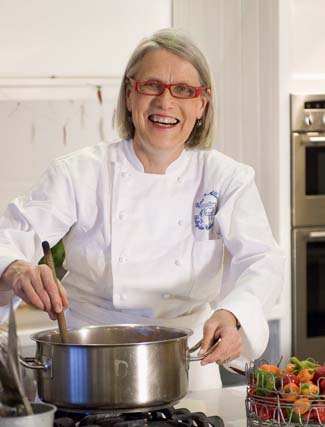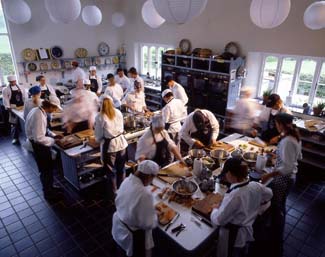The Darina Allen Column - Real Bread

This month Darina talks about Real Bread
Bread and our national loaf is a subject which continues to exercise me.
I’m totally in despair at the quality of our squishy sliced bread and deeply concerned about the effects on our health and waistline, many not least the Bakers Association of Ireland would disagree with me and I certainly hope they are right. I myself can’t seem to find out what exactly is in the bread, an enormously important staple for many people. Flour, yeast, salt, water, so far so good, but what else to speed up the process and produce a loaf at this price.
The term ‘processing aids’ seems to cover a multitude of enzymes, improvers and preservatives which don’t have to be put on the labels as ‘processing aids’ are exempt, so much for transparency...
The good news however is that in pockets here and there around the country, artisan bakeries are bubbling up in response to the craving for real bread.
In Cork City, Declan Ryan came out of retirement in 1999 and started to bake real bread in his garage, Arbutus Artsian Bakery, which morphed into a large bakery employing eight full time bakers in Mayfield. Declan sells at Farmers Markets and specialist shops as far away as Dublin. He, like many others who were inspired by him can scarcely keep up with demand. Also in the Cork area - ABC Breads in the English Market and Pavel Piatrousky from Pana Bread in Midleton have their loyal devotees.
Another of the pioneers, Sarah Richards who established Seagull Bakery in Tramore in 2013 was also inspired by Declan Ryan.
In January 2015, Real Bread Ireland was started by a small group of craft bakers as a support network for those who wished to learn how to make real bread either professional or at home.
So what exactly is Real Bread? Well, in its purest form, it is bread without the use of processing aids or any other artificial additives. Real Bread is made without improvers, dough conditioners, preservatives, chemical leavening (baking powder or bicarbonate of soda) any other artificial additives or the use of pre mixed ingredients.
That pretty much rules out 90% of the bread on our supermarket shelves but the good news is there’s a quiet revolution going on at grass roots level, small craft bakers are popping up here and there around the country, the use of organic and heirloom flours is increasing significantly, the general public is becoming aware that something is amiss as the number of people with a gluten intolerance continues to sky rocket. A growing body of disquieting research is emerging on the effects of the random use of glyphosate on wheat both as a herbicide and before harvesting on our health and the environment.
‘Making a long and slowly fermented sourdough’ is certainly a mission, but a loaf of soda bread, the traditional breads of our country is literally mixed in minutes. A few scones will be out of the oven in 10 or 12 minutes while a crusty loaf will be ready in 35 or 40.
Few things we do, give so much pleasure and nourishment for so little effort. A truly nourishing, wholesome national loaf would do much to enhance the health of the nation. This was done in Norway in the 1970’s with remarkable results.
Here are two recipes for different kinds of breads but for those who would like to get started on sourdough Riot Rye Bakery at Cloughjordan gives full instructions for The Common Loaf on their website and believe me, once you do there’s no going back. Many bakers including the Ballymaloe Cookery School will share some of their sourdough starter free with keen beginners. (Please telephone ahead).
Meanwhile, be careful, much of the bread that’s sold as ‘sourdough’ contains yeast which is not at all the same as a natural sourdough.
Shipton Mill Flour
John Lister was only 20 when he and a few friends chanced upon the ruined Shipton Mill in the Cotswolds. They restored both the building and the mill wheel and started to stonegrind organic flour in the 1980s.
Shipton Mill quickly developed a cult following among the growing number who were anxious to source organic flour milled in the time honoured way. In recent years the demand for ancient grains has really gathered momentum, kamut, einkorn, spelt, durum, amaranth, buckwheat, chestnut, teff, sorghum, quinoa….now the next generation is happily and passionately involved – John’s daughter Tess recently wrote a Handful of Flour, Recipes from Shipton Mill published by Headline which shares the knowledge and tells the story of the bread revolution. www.shipton-mill.com
Another ‘must have’ for ‘wannabe’ bread makers is Andrew Whitley’s Bread Matters published by Fourth Estate.
RECIPES
Shipton Mill Burger Buns
These buns are perfect for a variety of barbecued meats, not just burgers. They taste great with pulled pork, or slow cooked beef with relish. You need a bun light enough not to be overly heavy once packed with its filling, but substantial enough to keep its shape and not fall to pieces in your hands. If you want to add seeds to the top, lightly spray water on top of the buns just before they go in the oven and sprinkle over onion, sesame or poppy seeds. The dough is subtly enriched, to make the bun more luxurious than a standard floury burger bap.
Makes 10 burger buns
190g water
70g Wheat Sourdough Starter for flavour, not for fermentation purposes (if you don’t want to use this you can add 35g more flour and 35g more water instead)
10g fresh yeast
500g strong white flour (ciabatta flour also works well)
1 small egg, beaten
60g rapeseed oil (or sunflower oil), plus a little extra for the bowl
30g sugar
10g salt
semolina, for dusting
Mix the water and starter together in a mixing bowl and add the yeast. Slowly stir until combined then add the flour.
Place the egg, rapeseed oil, sugar and salt in a separate bowl and combine by hand using a fork. Add this to the flour mix and slowly stir to create a dough, until the ingredients are evenly incorporated.
Knead the dough (either by hand or using an electric stand mixer fitted with a dough hook) until it is elastic and smooth, with a lovely shine. Transfer to a lightly oiled bowl, cover with a cloth, and rest at room temperature for 45 minutes to 1 hour.
Place your semolina in a large wide plate. Divide your dough into ten 80–90g lumps.
Roll these by hand into round roll shapes, then roll them all over in the semolina, and place them on a baking tray. (If you want to sprinkle the tops with seeds, just roll the base in the semolina and keep the top clear.)
Keep them at least 8cm apart to allow them to rise. Cover, and leave them to prove at room temperature for a further 2 hours, or until doubled in size. Towards the end of this time preheat your oven to 180ºC/gas 4.
Place around 12 ice cubes in an ovenproof dish in the bottom of your oven to create steam. Remove the ice cubes just before you want to bake your buns.
Place your buns in the oven, and bake for 14–17 minutes, until golden. Leave to cool on a wire rack.
A Handful of Flour Recipes from Shipton Mill
Spotted Dog
A variation on traditional Irish soda bread that’s a favourite at Ballymaloe.
Makes 1 loaf
450g (1lb/4 cups) plain white flour, preferably unbleached
1 level teaspoon bicarbonate of soda
1 level teaspoon salt
2 teaspoons sugar
75g (3oz) sultanas (or more if you’d like)
1 organic egg
about 350 - 425ml (12-14fl oz/1 1/2 – 1 3/4 cups) buttermilk
Preheat the oven to 220°C/425°F/gas mark 7.
In a large mixing bowl, sieve in the flour and bicarbonate of soda; then add the salt, sugar and sultanas. Mix well by lifting the flour and fruit up in to your hands and then letting them fall back into the bowl through your fingers. This adds more air and therefore more lightness to your finished bread. Now make a well in the centre of the flour mixture.
Break the egg into the base of a measuring jug and add the buttermilk to the 425ml (14fl oz/1 3/4 cup) line (the egg is part of the liquid measurement). Pour most of this milk and egg mixture into the flour. Using one hand with the fingers open and stiff, mix in a full circle drawing in the flour mixture from the sides of the bowl, adding more milk if necessary. The dough should be softish, but not too wet and sticky.
The trick with Spotted Dog, like all soda breads, is not to over mix the dough. Mix it as quickly and gently as possible, thus keeping it light and airy. When the dough all comes together, turn it out onto a well-floured work surface. Wash and dry your hands. With floured fingers, roll the dough lightly for a few seconds – just enough to tidy it up. Then pat the dough into a round about 6cm (2½ inches) deep.
Transfer to a baking tray dusted lightly with flour. Use a sharp knife to cut a deep cross on it, letting the cuts go over the sides of the bread. Prick with knife at the four triangles. Put into the oven and immediately reduce the temperature to 200°C/400°F/Gas Mark 6. Cook for 35-40 minutes. If you are in doubt about the bread being cooked, tap the bottom: if it is cooked it will sound hollow. This bread is cooked at a lower temperature than soda bread because the egg browns faster at a higher heat.
Serve freshly baked, cut into thick slices and smeared with butter and jam. Spotted Dog is also really good eaten with Cheddar cheese.
Ballymaloe LitFest 2017
The fifth annual Ballymaloe LitFest runs from Friday 19th to Sunday 21st May 2017, and all of the events over this exciting and stimulating weekend are now confirmed, scheduled and available to book on www.litfest.ie
---
'30 Years at Ballymaloe' - Bord Gáis Avonmore Cookbook of the Year 2013
Good Food Ireland Cookery School of the Year 2012/2013
***
 Once again, the Ballymaloe Cookery School in East Cork has a great programme of cookery courses for all interests and abilities running throughout 2017. Ranging from a relaxing visit to sit in on an afternoon cookery demonstration to a week long ‘Intensive Introductory Course’.
Once again, the Ballymaloe Cookery School in East Cork has a great programme of cookery courses for all interests and abilities running throughout 2017. Ranging from a relaxing visit to sit in on an afternoon cookery demonstration to a week long ‘Intensive Introductory Course’.
Sitting in the middle of a 100 acre organic farm the Ballymaloe Cookery School provides its students not only with a life skill learnt under the expert tutelage of their very capable teachers but also a place to relax and unwind from the stresses and strains of normal everyday life. The cottage accommodation available onsite for residential courses consists of a collection of delightful converted outbuildings which have been transformed over the years by the Allens, and other accommodation is available locally for the short courses.
www.cookingisfun.ie





There are currently no comments
Leave a comment
Not a member? Register for your free membership now!
Or leave a comment by logging in with: